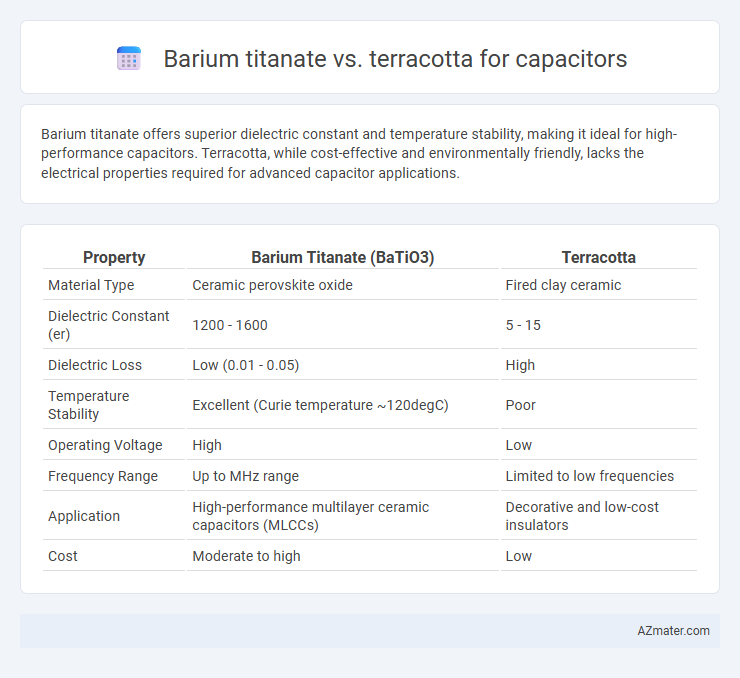Barium titanate offers superior dielectric constant and temperature stability, making it ideal for high-performance capacitors. Terracotta, while cost-effective and environmentally friendly, lacks the electrical properties required for advanced capacitor applications.
Table of Comparison
| Property | Barium Titanate (BaTiO3) | Terracotta |
|---|---|---|
| Material Type | Ceramic perovskite oxide | Fired clay ceramic |
| Dielectric Constant (er) | 1200 - 1600 | 5 - 15 |
| Dielectric Loss | Low (0.01 - 0.05) | High |
| Temperature Stability | Excellent (Curie temperature ~120degC) | Poor |
| Operating Voltage | High | Low |
| Frequency Range | Up to MHz range | Limited to low frequencies |
| Application | High-performance multilayer ceramic capacitors (MLCCs) | Decorative and low-cost insulators |
| Cost | Moderate to high | Low |
Introduction: Barium Titanate vs Terracotta in Capacitors
Barium titanate is a widely used ceramic material in capacitors due to its high dielectric constant and excellent ferroelectric properties, enabling superior energy storage and stability. Terracotta, a natural clay-based material, exhibits lower dielectric performance and limited temperature stability, making it less suitable for advanced capacitor applications. When comparing barium titanate and terracotta, barium titanate's enhanced electrical characteristics dominate in high-performance capacitor manufacturing.
Material Composition and Structure
Barium titanate (BaTiO3) is a ceramic perovskite material characterized by a crystalline structure that exhibits high dielectric constant and ferroelectric properties, making it ideal for multilayer ceramic capacitors (MLCCs). Terracotta, primarily composed of fired clay with a porous and amorphous microstructure, has significantly lower dielectric permittivity and is not commonly used in capacitor manufacturing. The intrinsic material composition and crystallinity of barium titanate result in superior electrical performance compared to the earthy, non-crystalline terracotta material.
Dielectric Constant Comparison
Barium titanate exhibits a significantly higher dielectric constant, typically ranging from 1,000 to 10,000, compared to terracotta's dielectric constant, which usually falls below 20. This large difference makes barium titanate a superior material for high-capacitance applications in multilayer ceramic capacitors (MLCCs). Terracotta, owing to its low dielectric constant, is rarely used in capacitors and instead serves as an insulating or structural material in electronic components.
Temperature Stability and Performance
Barium titanate capacitors exhibit superior temperature stability due to their high dielectric constant and ferroelectric properties, maintaining consistent capacitance over a wide temperature range. Terracotta, primarily a ceramic material, offers poor temperature stability and lower dielectric performance, which limits its use in high-precision capacitor applications. The dielectric loss and temperature coefficient of barium titanate capacitors make them ideal for applications requiring reliable performance under thermal stress.
Capacitance Ratings and Efficiency
Barium titanate exhibits high dielectric constant values typically ranging from 1,000 to 10,000, making it ideal for capacitors that require superior capacitance ratings and energy storage efficiency. Terracotta, being a natural ceramic material, generally offers much lower dielectric constants, around 10 to 100, resulting in significantly reduced capacitance and efficiency for capacitor applications. The superior dielectric properties of barium titanate enable smaller capacitor sizes with higher performance, making it the preferred choice over terracotta in high-efficiency capacitor manufacturing.
Manufacturing Processes and Scalability
Barium titanate capacitors utilize ceramic sintering techniques involving precise powder processing and high-temperature firing, enabling high dielectric constant and miniaturized components suited for mass automated production. Terracotta capacitors, crafted from natural clay through manual molding and low-temperature kiln firing, face limitations in uniformity and scalability due to traditional artisanal methods. The advanced industrial manufacturing processes of barium titanate enable superior scalability and consistency compared to the more labor-intensive and variable terracotta capacitor production.
Cost Analysis and Availability
Barium titanate offers high permittivity making it ideal for advanced capacitors, but its cost is significantly higher due to complex synthesis and raw material expenses. Terracotta, being abundant and inexpensive, provides a budget-friendly option but with lower dielectric properties, limiting its use in high-performance capacitors. Availability of barium titanate is limited to specialized suppliers, while terracotta is widely accessible, impacting large-scale production and cost efficiency.
Environmental and Safety Considerations
Barium titanate offers excellent dielectric properties for capacitors but poses environmental concerns due to its lead content and potential toxicity during manufacturing and disposal. Terracotta, being a natural clay material, is eco-friendly, non-toxic, and biodegradable, reducing environmental impact and health risks. Safety protocols are critical when handling barium titanate to prevent exposure, while terracotta-based capacitors present fewer hazards and easier waste management.
Typical Applications in Electronics
Barium titanate is widely used in multilayer ceramic capacitors (MLCCs) due to its high dielectric constant and excellent temperature stability, making it ideal for applications in consumer electronics, automotive sensors, and power supply filters. Terracotta, with its natural porous structure and lower dielectric permittivity, is less common in advanced electronic capacitors but finds niche use in traditional or low-frequency applications where cost-effectiveness and mechanical robustness are prioritized. Barium titanate capacitors dominate applications requiring high capacitance and miniaturization, while terracotta remains a material choice in specialized, low-tech or high-temperature capacitor designs.
Future Trends and Innovations in Capacitor Materials
Barium titanate remains a leading ferroelectric material in capacitor technology due to its high dielectric constant and stability at varying temperatures, enabling advancements in miniaturized and high-performance capacitors. Terracotta, an emerging sustainable ceramic composite, offers potential eco-friendly benefits but requires innovation to achieve comparable dielectric properties and frequency response. Future trends focus on enhancing barium titanate through doping and nanostructuring, while integrating terracotta-based materials with conductive polymers to balance sustainability and performance in next-generation capacitors.

Infographic: Barium titanate vs Terracotta for Capacitor
 azmater.com
azmater.com